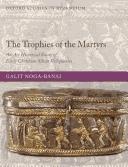| Listing 1 - 4 of 4 |
Sort by
|
Book
ISSN: 09470611 ISBN: 9783447107327 3447107324 Year: 2017 Volume: 13 Publisher: Wiesbaden : Harrassowitz,
Abstract | Keywords | Export | Availability | Bookmark
 Loading...
Loading...Choose an application
- Reference Manager
- EndNote
- RefWorks (Direct export to RefWorks)
This study centers around Byzantine head relics and their receptacles. The first part discusses the so-called Reliquary of St. Anastasios the Persian, a silverwork in the shape of a centralized, domed church that was probably made in Antioch, but was later housed in Aachen Cathedral. The object is commonly considered a Byzantine vessel for the Eucharist that was later reworked to become a reliquary for the head of St. Anastasios in its new Western context. This study closely examines the life and cult of this particular saint in Byzantium and Aachen by considering the object's typology and contextualizing relations between Antioch and Constantinople in the late 10th century that have been largely overlooked, shedding light on the handling of sacred objects and confiscation measures under Basil II. The second part of the study concerns the veneration of Byzantine head relics in Constantinople and, more specifically, head relics that were transferred to the West in the aftermath of the Fourth Crusade. A discussion of Latin, post-1204 sources which affected medieval and modern perceptions of Byzantine relic veneration counters a bias against Byzantine sacred goldsmith work discernable in scholarship of the mid-20th century. Together with appendices on the anatomical nomenclature of the human skull, skull-chalices, and selected sacred objects made of precious metal related to relic veneration and the Eucharist, this study aims to reconstruct head reliquary types. It also seeks to refute the claim in art history that simple caskets that can easily be opened were commonly used as reliquaries of Byzantine body relics.
Reliquaries, Byzantine --- Saints --- Cult --- Anastasius, --- Anastasius Persa m. Betsaloae --- Reliquaires byzantins
Book
ISBN: 3895003166 9783895003165 Year: 2004 Volume: Bd. 17 Publisher: Wiesbaden Reichert
Abstract | Keywords | Export | Availability | Bookmark
 Loading...
Loading...Choose an application
- Reference Manager
- EndNote
- RefWorks (Direct export to RefWorks)
Reliquaries, Byzantine. --- Reliquaries, Medieval. --- Holy Cross. --- Reliquaires byzantins --- Reliquaires médiévaux --- Sainte Croix --- Reliquaries, Byzantine --- Reliquaries, Medieval --- Holy Cross --- Reliquaires médiévaux --- Medieval reliquaries --- Byzantine reliquaries --- Relics and reliquaries, Byzantine --- Cross --- Feast of the Cross --- Reliques --- Croix
Book
ISBN: 9782503542126 2503542123 Year: 2012 Volume: 20 Publisher: Turnhout : Brepols
Abstract | Keywords | Export | Availability | Bookmark
 Loading...
Loading...Choose an application
- Reference Manager
- EndNote
- RefWorks (Direct export to RefWorks)
C'est à partir de la Paix de l'Église que le culte des martyrs jusqu'alors interdit et caché, limité aux cimetières, s'est développé de façon officielle, prenant place dans les églises. Les premiers reliquaires apparus en Palestine et en Syrie connurent un grand essor aux Ve et VIe siècles dans ces provinces ainsi qu'en Arabie. L'ouvrage se compose de deux parties : un texte de synthèse (première partie) et un inventaire sous forme de catalogue (deuxième partie). Se fondant sur les exemples du catalogue, l'auteur a procédé à l
Reliquaries, Byzantine --- Liturgical objects --- Christian art and symbolism --- Reliquaires byzantins --- Objets liturgiques --- Art et symbolisme chrétiens --- Reliquaries --- Art et symbolisme chrétiens --- Reliquaries - Middle East --- Reliquaries, Byzantine - Middle East --- Reliquaries - Cyprus --- Reliquaries, Byzantine - Cyprus --- Christian art and symbolism - Medieval, 500-1500 --- Christian art and symbolism - To 500

ISBN: 9780199217748 0199217742 019152722X 9780191527227 9786611515317 6611515313 1281515310 1383035717 Year: 2008 Volume: *3 Publisher: Oxford New York Oxford University Press
Abstract | Keywords | Export | Availability | Bookmark
 Loading...
Loading...Choose an application
- Reference Manager
- EndNote
- RefWorks (Direct export to RefWorks)
Galit Noga-Banai analyses silver reliquaries decorated with Christian figurative themes, offering a clearer and more detailed picture of the beginnings of the cult of relics in the early Church.
Reliquaries, Byzantine --- Silverwork, Byzantine --- Silverwork, Early Christian --- 73.033.1 --- 247 "00/04" --- 235.3*22 --- 235.3*22 Hagiografie: reliquiae --- Hagiografie: reliquiae --- 73.033.1 Vroegchristelijke beeldhouwkunst --- Vroegchristelijke beeldhouwkunst --- Early Christian silverwork --- Byzantine silverwork --- Silversmithing, Byzantine --- Byzantine reliquaries --- Relics and reliquaries, Byzantine --- Kerkdecoratie. Kerkmeubilair--?"00/04" --- Reliquaries, Byzantine. --- Silverwork, Byzantine. --- Silverwork, Early Christian. --- Reliquaires byzantins --- Orfèvrerie byzantine --- Orfèvrerie paléochrétienne --- Reliquaires
| Listing 1 - 4 of 4 |
Sort by
|

 Search
Search Feedback
Feedback About UniCat
About UniCat  Help
Help News
News